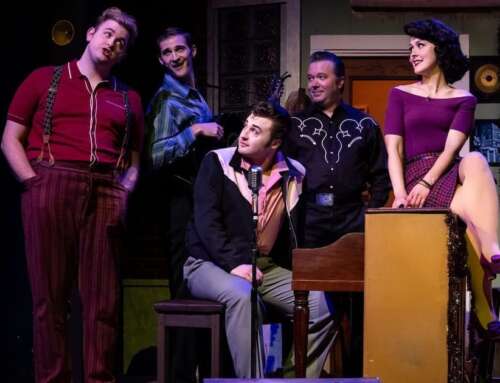No, not August Wilson’s The Piano Lesson (for that, you’ll have to venture to New York where Samuel L. Jackson is currently helming a splashy revival of Wilson’s classic). This is The Piano Teacher – also no relation to the 2001 movie – a brooding memory play about characters who have trouble remembering the past.
Julia Cho’s work premiered in 2007 and follows retired piano teacher Mrs. K (Jennifer McCray Rincón) who lives a quiet life in her small apartment. She lives alone and passes the time by reminiscing about her late husband, watching television, and thinking about the children she taught long ago. Mrs. K finds herself compelled to call her old students, but is it out of loneliness or some other, darker need? As students start to respond, Mrs. K is forced to confront truths about her husband that she would prefer to remain buried. This play was influenced by piano lessons Cho took as a child and was written immediately after Cho learned about the Rwandan genocide.
As you enter the theatre, set designer Michael R. Duran forces you into a divided apartment that is infused with forced symmetry. On one side of the stage is Mrs. K’s cluttered chair, with books, food, and old electronics. At center stage is the piano she uses for her lessons and pictures of her late husband and mother. On the opposite side of the stage eerily sits Mr. K’s chair with a single newspaper. Three blue windows and two brown doors symmetrically frame the stage and unite the three spaces. It’s a picture-perfect image of domesticity. Or is it?
The more Mrs. K talks, the more we realize she’s hiding – or, rather, denying – something. The play’s opening moment was cleverly constructed; artificial light poured out of the television, while news reporters describe the genocide in Rwanda, the war in Ukraine, and the invasion of Myanmar. Mrs. K is partially lit as she passively listens to these horrors. As with much of her life, Mrs. K can do nothing but watch and attempt to distract herself from the tragedy of reality.
Rincón has a lot of dialogue to deliver; as Dwyane Carrington’s director’s note mentions, Cho’s writing relies heavily on monologues. Rincón’s physicality as the injured, aged teacher is impressive, though her delivery of long passages of text is a bit monotonous and rushed. Cho writes Mrs. K best when she is being challenged by characters outside of her carefully controlled home and not communicating through long-winded, repetitive monologues. Unfortunately, these moments are few and far between.
Rincón is best when she reacts to her co-stars’ strong work. Cheryl Sarkaria plays Mary, a former student of Mrs. K who has given up on the piano and now lives peacefully with her husband and two kids. Sarkaria expertly embodies her character’s desire for normalcy. Mary wants the best for Mrs. K but mostly wants to put the dark stories from her piano lessons behind her. Sarkaria and Rincón’s transition from friendly to accusatory back to amicable with ease.
Bobby Bennett has fantastic energy as Michael. Though he appears in a single scene near the end of the play, his stage presence is powerful. Bennett’s full-bodied physicality is chilling, and his performance is the play’s high point. Kathi Baerns, Kelly Alayne Dwyer, and Michael Gurhtein appear briefly as a gaggle of voices from Mrs. K’s past, and made me wish Cho had included more scenes with other characters’ voices.
Carrington’s direction of the show’s technical elements is solid. Emily Maddox’s lighting design impressively balances the character’s transitions between the set’s three playing spaces. She subtly adds colors throughout and creates a lot of cool shadows. Maddox uses a gobo on the lighting instrument to create a window effect (or is it a cage?) for when Mrs. K is near the piano is incredibly well-executed. Prop designer Kortney Hanson fills the space with perfectly placed trinkets and trash, making Mrs. K’s apartment feel lived-in.
Sound designer Cece Smith creates a constant, unnatural underlying soundscape for Mrs. K’s lonely apartment; combining dull sounds from the television and apartment with key sounds from Mrs. K’s stories. Despite strong sound selection, they are occasionally mixed too loud for the space, and Rincón and the other actors are – confusingly – directed to not react to these sounds.
The show’s staging is one-sided and clumped around Mrs. K’s chair. Though this choice is textually motivated by Mrs. K’s injury, it is visually static. In contrast, Carrington over-directs the play’s few moments of action. For example, during Mrs. K’s first phone conversation with Mary, there are so many stiff, calculated movements blocked into their short conversation that it becomes distracting.
The Piano Teacher is a cold drama that overwhelms the audience with trauma. Unless you’re in the mood for melancholy, I’d recommend checking out Vintage’s other offering, The Drowsy Chaperone, a very fun musical playing through Oct. 9.
A Colorado-based arts reporter originally from Mineola, Texas, who writes about the changing world of theater and culture, with a focus on the financial realities of art production, emerging forms and arts leadership. He’s the Managing Editor of Bucket List Community Cafe, a contributor to Denver Westword and Estes Valley Voice, resident storyteller for the Bonfils-Stanton Foundation and co-host of the OnStage Colorado Podcast. He holds an MBA and an MA in Theatre & Performance Studies from CU Boulder, and his reporting and reviews combine business and artistic expertise.





Leave A Comment